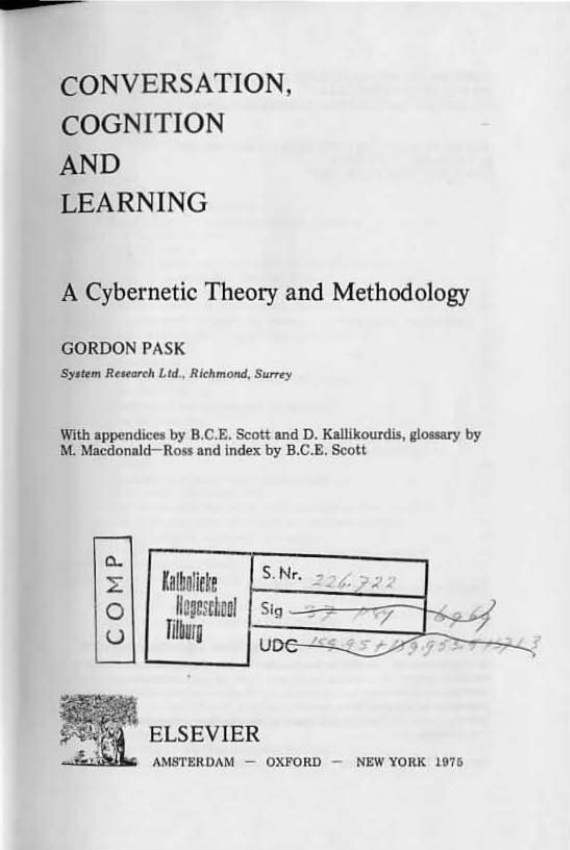Gordon Pask: Conversation, Cognition and Learning. A Cybernetic Theory and Methodology (1975)
Filed under book | Tags: · cognition, communication, cybernetics, education, learning, psychology

“The work on which the content of this book is centred took place over more than a decade. It started, in the middle fifties, with the construction of adaptive training machines, with superficially disconnected studies of chemical computing systems, and, towards 1960, with experiments on machine-monitored small group inter-action. Since that period an underlying theory has emerged from a gaggle of prescient concepts. It owes a great deal of its present shape to the ideation and criticism of friends and colleagues, only some of whom can be mentioned directly.
First of all, it is noteworthy that parallel work has gone on in two places; my own laboratory at System Research Ltd and in Heinz Von Foerster’s Biological Computer laboratory, at the University of Illinois. Both endeavours were encouraged by Warren McCulloch; the reader will detect the influence of his ideas and guidance appearing repeatedly throughout the discussion. Apart from this, the parallel development was not specially contrived and it was sustained by irregular personal liason. Hence, it is gratifying to find that recent publications from the Biological Computer Laboratory image our own conclusions, differing, chiefly, in the notation employed and the area of application. People familiar with the field will probably find the threads of mutualism quite obvious; for the benefit of others, a few of these threads are picked out. For example, Loefgren worked with Von Foerster whilst refining the formalism on which the currently-used type of abstract reproductive and evolutionary process is founded; Maturana (whose theory of autopoietic systems is the analogue, in a biologist’s mind, for certain stable cognitive organisations in the present theory) worked there as well; Maturana’s theory is to appear in a subsequent monograph in this series. Both Ashby, the system theorist, and Gunther, the philosopher, taught and researched with Von Foerster; much of the present theory hinges upon their ideas.
On home ground, the theory, and the experiments as well, owe a great deal to two colleagues of long standing: Brian Lewis and Bernard Scott. Prof. Lewis and I shared a common interest in cognition since early in the 1960s and brooded jointly (as we still do) over problems of learning and teaching. Bernard Scott came to the laboratory at the time when Lewis went off to study education in the large and since that time we have maintained a comparably symbiotic intellectual relationship. At about the time I started to write this manuscript (having discarded many previous drafts of it as inadequate) both circumstance and research interest brought all of us into close contact again and we were joined, in the last year, by Dionysious Kallikourdis (who contributes one Appendix, explicitly).” (Gordon Pask, from Preface)
With appendices by B.C.E. Scott and D. Kallikourdis, glossary by M. Macdonald-Ross and index by B.C.E. Scott
Publisher Elsevier, Amsterdam/Oxford/New York, 1975
ISBN 0444411933, 9780444411938
570 pages
via pangaro.com
PDF (updated on 2012-7-16)
Comment (0)Niklas Luhmann: Art as a Social System (1995/2000)
Filed under book | Tags: · aesthetics, art, art system, autopoiesis, communication, cybernetics, perception, romanticism, social theory, systems theory

This is the definitive analysis of art as a social and perceptual system by Germany’s leading social theorist of the late twentieth century. It not only represents an important intellectual step in discussions of art—in its rigor and in its having refreshingly set itself the task of creating a set of distinctions for determining what counts as art that could be valid for those creating as well as those receiving art works—but it also represents an important advance in systems theory.
Returning to the eighteenth-century notion of aesthetics as pertaining to the “knowledge of the senses,” Luhmann begins with the idea that all art, including literature, is rooted in perception. He insists on the radical incommensurability between psychic systems (perception) and social systems (communication). Art is a special kind of communication that uses perceptions instead of language. It operates at the boundary between the social system and consciousness in ways that profoundly irritate communication while remaining strictly internal to the social.
In seven densely argued chapters, Luhmann develops this basic premise in great historical and empirical detail. Framed by the general problem of art’s status as a social system, each chapter elaborates, in both its synchronic and diachronic dimensions, a particular aspect of this problem. The consideration of art within the context of a theory of second-order observation leads to a reconceptualization of aesthetic form. The remaining chapters explore the question of the system’s code, its function, and its evolution, concluding with an analysis of “self-description.”
Art as a Social System draws on a vast body of scholarship, combining the results of three decades of research in the social sciences, phenomenology, evolutionary biology, cybernetics, and information theory with an intimate knowledge of art history, literature, aesthetics, and contemporary literary theory. The book also engages virtually every major theorist of art and aesthetics from Baumgarten to Derrida.
Originally published in German in 1995 under the title Die Kunst der Gesellschaft, Suhrkamp, Frankfurt am Main
Translated by Eva M Knodt
Publisher Stanford University Press, 2000
Meridian: Crossing Aesthetics series
ISBN 0804739072, 9780804739078
422 pages
PDF (updated on 2012-7-17)
Comment (0)George Myerson: Heidegger, Habermas and the Mobile Phone (1997)
Filed under book | Tags: · communication, fascism, mobile technology, philosophy, technology

Global mobile telephony is at the cutting edge of the communications revolution. Humanity, for Martin Heidegger, is ‘the entity that talks’; Jurgen Habermas is a passionate advocate of authentic human interaction. Both are key thinkers in this encounter between alien visions of communication and the utopianism of the 20th and 21st centuries.
Publisher Icon, 2001
Postmodern encounters
ISBN 1840462361, 9781840462364
80 pages
PDF (updated on 2013-2-6)
Comment (0)
